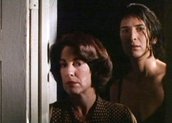


Vacant Possession (1994)
Synopsis
After the death of her mother, Tessa (Pamela Rabe) returns to Australia and moves back into the family’s run-down house on the shores of Botany Bay. She argues with her sister Kate (Linden Wilkinson) over who will inherit the house and refuses to see her father Frank (John Stanton). His drunken violence, caused by a traumatic war, drove her away at 16. From her Aboriginal neighbours, Tessa learns that Mitch (Graham Moore), the boy she loved then, has died. Tessa is haunted by his memory and the trauma of her childhood. These memories become very real during long nights alone in the house. Her only comfort is a new friendship with Millie (Olivia Patten), the teenage granddaughter of Aunty Beryl (Rita Bruce), the mother of Mitch. When a huge storm batters the house, Tessa has to confront her hatred and fear of her father.
Curator’s notes
Vacant Possession was Margot Nash’s ambitious feature debut, after a long career in documentary. The film has a strong political basis, but it’s ultimately a very personal story. The politics are to do with questions of prior ownership and Aboriginal land rights. The house is on the shores at Botany Bay because that is where white settlement began.
The title refers both to the vacant house, in which Tessa’s memories lurk like ghosts, waiting to ambush her, and to the legal fiction of ‘terra nullius’ that was used to justify the white colonisation of Australia – the idea that the land was empty when Captain Cook sailed into the bay in 1770. The film is concerned with the future of black and white relations in this country, not just the past. It dramatises a white sense of anxiety about the way forward. Tessa is stuck once she sets foot back on Australian soil. Her grief over her mother – whom she loved – becomes magnified by her grief over Mitch, when she finds out he has died. Thus, Tessa is cast as a woman caught between both cultures, unable to do anything but drink and dream until she confronts the past.
Each of the main characters is haunted by similar regrets. No-one in this movie is unscarred by the past, but the ones who live here have reached a state of acceptable denial. Tessa hasn’t been able to do that, because she’s been overseas, making a meagre living as a professional gambler. Vacant Possession is an attempt at a new beginning for her character, but not just her’s. The violent storm that ends the film destroys the house, but also brings the races together. Possession, in that sense, has been declared ‘vacant’ once more.
Secondary curator’s notes
by Sophia SambonoVacant Possession tells the story of prodigal daughter Tessa who returns home to Australia after the death of her mother. She retreats to her childhood home, 'Irene’, setting the scene for a confronting recollection of her tragic past and issues of Australia’s unresolved colonial history. It is within this setting that Nash interweaves the themes of reconciliation with the past and between races.
In a 1995 interview with Cinema Papers Nash stated, ‘We have colonised this country; we’re living in a post-colonial society, trying to understand what that means, and trying to find our place and sense of belonging’.
The story is set in Botany Bay, the site of British settlement, and the British assertion of ‘terra nullius’ resonates throughout the film. The issues of ownership and possession pervade as the phrase ‘they think they own the place’ is repeated (see clip one).
By switching between Tessa’s childhood of the 1950s and the film’s contemporary 1990s, Vacant Possession is a telling snapshot of Australian values and attitudes towards Aboriginals. The representation of Indigenous people doesn’t stray far from popular stereotypes of the 1990s. There is a sense of mysticism surrounding Tessa’s encounters with her Aboriginal friends and neighbours, including her dreamlike recollections of Mitch’s spirit animal, the snake, reinforced by mention of the mysterious ‘snakeman’.
When Aboriginals are not being spiritual or mystical in the film they are cheeky and irreverent. Especially Millie, the young Aboriginal girl, who also represents the child Tessa and Mitch could have had. Millie’s cat is named ‘Captain Cook’ or ‘Cookie’, not because he is white as Tessa assumes but ‘because we didn’t invite him and then he wouldn’t go away’. When she does a school project on Cook’s discovery of ‘a great uninhabited land’, Millie jokes, ‘Bad eyesight, eh?’. These remarks tie into the themes of ownership and possession, as do posters in Millie’s room of land rights campaigns, Mabo and the Aboriginal flag.
These moments, while well intended, feel heavy-handed and cringe-worthy. Nash talked about this process, in her Cinema Papers interview, about the difficulties of being overtly 'politically correct’ and only ending up in 'cliche land’. Nash has experience working with Aboriginal people and in mentoring Aboriginal filmmakers, but she has said herself that, 'I came to understand that as a white person I couldn’t tell Aboriginal stories. That’s for Aboriginal people to do.’
- Overview
- Curator’s notes
- Video 3 clips
- Principal credits
- Find a copy
- Make a comment
- Map
- Add your review




